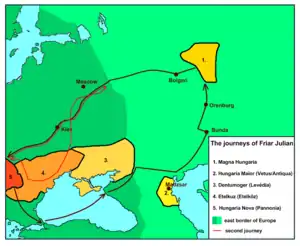
The term Eastern Hungarians (Hungarian: Keleti magyarok; or "Eastern Magyars") is used in scholarship to refer to peoples related to the Proto-Hungarians, that is, theoretically parts of the ancient community that remained in the vicinity of the Ural Mountains (at the European–Asian border) during the Migration Period and as such did not participate in the Hungarian conquest of the Carpathian Basin.
The possible locations of the remnants of Hungarians
Yugra
Yugra (Greek: Οὔγγροι) has been believed by some to have been the Hungarian Urheimat (homeland), which is today inhabited by the Mansi and Khanty, two related ethnic groups.[1][2]
Magna Hungaria
The term "Eastern Hungarians" is also used in relation to the Magna Hungaria of Friar Julian (fl. 1235), located at Bashkortostan (the land of the Bashkirs).[3][4] where Julian was able to communicate with the locals in his Hungarian language.[5]
Savard Hungarians
According to Hungarian scholarship, there was a group of "Savard Hungarians" that broke off and moved across the Caucasus into Persian territory in the 8th century.[6][7]
Theory of Kummagyaria
There is also the theory of "Kummagyaria" (Latin: Cummageria),[8] in which a group that stayed behind possessed a country north of Caucasus. According to László Bendefy, the approximate location of Kummagyaria is the riparian area of the Kuma River, Southern Russia. Odorico Raynaldi (1595–1671) mentioned Papal relations with Jeretany (Hungarian: Gyeretyán), called the ruler of Hungarians, Malkaites and Alans, in the 1320s.[9][10] Earlier, Polish diplomat Andrzej Taranowski (1569) had mentioned the latter information.[11] In 1712, the French traveller Aubrey de la Motraye passed through the area. His notes state that from what he heard from the local Tatar population, he maintained that the city of Mazsar was formerly inhabited by Magyars.[12]
See also
References
- ↑ Daniel Abondolo (8 April 2015). The Uralic Languages. Routledge. p. 389. ISBN 978-1-136-13500-2.
After the speakers of proto-Hungarian broke away (roughly seventh to fifth century BC), the linguistic ancestors of the Khanty and the Mansi remained in western Siberia, where they ...
- ↑ Denis Sinor (March 1990). The Cambridge History of Early Inner Asia. Cambridge University Press. p. 254. ISBN 978-0-521-24304-9.
Mansi (cognate with the Hungarian Magy-ar) and Khanty which probably denotes "people" (cf. the cognate Hungarian had "army, host" < hodu, < Finn-Ugric *konta). The question of how the name Ugra etc., deriving perhaps from Onoghur, came to be applied to them by the Rus' and Arab ...
- ↑ Acta Ethnographica Hungarica. Vol. 53. Akadémiai Kiadó. December 2008. pp. 298–302.
- ↑ The Oxford Encyclopedia of Medieval Warfare and Military Technology: Vol. 1-. Oxford University Press. 2010. p. 139. ISBN 978-0-19-533403-6.
- ↑ Arnold Joseph Toynbee, Constantine Porphyrogenitus and his world, Oxford University Press, 1973, p. 421
- ↑ István Dienes (1972). The Hungarians cross the Carpathians. Corvina Press. p. 9.
Apart from the few groups remaining in Magna Hungaria and the Savard Hungarians who passed beyond the Caucasian Mountains towards the Persian ...
- ↑ Lajos Gubcsi, Hungary in the Carpathian Basin, MoD Zrínyi Media Ltd, 2011
- ↑ László Bendefy (1942). A magyarság kaukázusi öshazája: Gyertyán országa. Cserépfalvi.
- ↑ Társaság, Magyar Földrajzi (1942). Foldrajzi Kozlemenyek. Vol. 70. p. 162.
- ↑
The Pope was informed of the Asian Magyars', the Malkaites', and the Alans' firm commitment to the one true religion. These nations, despite being surrounded by a net of godless, superstitious rites, have maintained their immaculate belief in their faith. A highlight in this regard is Jeretany, the descendant of royal Magyar blood. Since he requested a Catholic emmissary from the Holy See, the Pope sent the bishop of Samarkand to him, in order to strengthen their faith, and to implore the religious men among them to remain steadfast.
- ↑
Greetings to our dear children, to Jeretany and all Christian Magyars, Malkaites & Alans! It has caused us rather great and natural happiness, that the Most Esteemed Creator, whose summons is constant and spreads to the entire world, to all those whom He chooses to discover His mercifulness, and for his only Son, with his love that is indescribable in words that constantly envelopes every single Christian family, embraces you, who have been touched by the true faith, the teaching of the Scriptures and the light of the Apostolic Church, amongst those of the Eastern parts of the world who are yet to accept the graces of Christianity.
- ↑ Tardy, Lajos. ’'Régi hírünk a világban'’, Gondolat, Budapest, 1979
Sources
- Pál Engel (22 July 2005). Realm of St. Stephen: A History of Medieval Hungary. I.B.Tauris. p. 99. ISBN 978-1-85043-977-6.
- Iván Boldizsár (1988). The New Hungarian Quarterly. Vol. 29. Lapkiadó Publishing House. p. 127.
- András Róna-Tas (1982). Chuvash studies. Akadémiai Kiadó. p. 52. ISBN 978-963-05-2851-1.